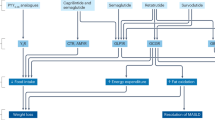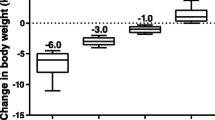Abstract
Among the challenges in improving outcomes in patients with diabetes is effectively implementing existing pharmacotherapies. However, current therapies for diabetes are often limited by adverse effects such as edema, hypoglycemia, and weight gain. Understanding the role of the incretin effect on the pathophysiology of diabetes has led to the development of new therapeutic agents. Exenatide is the first in a new class of agents termed “incretin mimetics,” which replicate several glucoregulatory effects of the endogenous incretin hormone, glucagon-like peptide-1. In clinical trials, patients with type 2 diabetes treated with exenatide demonstrate sustained improvements in glycemic control, with reductions in fasting and postprandial glucose levels and improvements in glycosylated hemoglobin levels. Improvements in glycemic control with exenatide are coupled with reductions in body weight. Lipid parameters, blood pressure, and C-reactive protein have been shown to improve favorably in patients treated with exenatide. The sustained glycemic improvements and progressive reduction in body weight with exenatide treatment support a shift toward a more favorable cardiovascular risk profile and may have a positive impact on decreasing the risk of associated long-term complications.
Similar content being viewed by others
References and Recommended Reading
Carr ME: Diabetes mellitus: a hypercoagulable state. J Diabetes Complications 2001, 15:44–54.
Haffner SM, Lehto S, Ronnemaa T, et al.: Mortality from coronary heart disease in subjects with type 2 diabetes and in nondiabetic subjects with and without prior myocardial infarction. N Engl J Med 1998, 339:229–234.
Astrup A: Healthy lifestyles in Europe: prevention of obesity and type II diabetes by diet and physical activity. Public Health Nutr 2001, 4:499–515.
Arner P: Insulin resistance in type 2 diabetes — role of the adipokines. Curr Mol Med 2005, 5:333–339.
Maggio CA, Pi-Sunyer FX: The prevention and treatment of obesity. Application to type 2 diabetes. Diabetes Care 1997, 20:1744–1766.
Intensive blood-glucose control with sulphonylureas or insulin compared with conventional treatment and risk of complications in patients with type 2 diabetes (UKPDS 33). UK Prospective Diabetes Study (UKPDS) Group. Lancet 1998, 352:837–853.
Koro CE, Bowlin SJ, Bourgeois N, Fedder DO: Glycemic control from 1988 to 2000 among U.S. adults diagnosed with type 2 diabetes: a preliminary report. Diabetes Care 2004, 27:17–20.
DeFronzo RA: Pharmacologic therapy for type 2 diabetes mellitus. Ann Intern Med 1999, 131:281–303.
Nauck M, Stockmann F, Ebert R, Creutzfeldt W: Reduced incretin effect in type 2 (non-insulin-dependent) diabetes. Diabetologia 1986, 29:46–52.
Kolterman OG, Buse JB, Fineman MS, et al.: Synthetic exendin-4 (exenatide) significantly reduces postprandial and fasting plasma glucose in subjects with type 2 diabetes. J Clin Endocrinol Metab 2003, 88:3082–3089.
Nauck MA, Kleine N, Orskov C, et al.: Normalization of fasting hyperglycaemia by exogenous glucagon-like peptide 1 (7-36 amide) in type 2 (non-insulin-dependent) diabetic patients. Diabetologia 1993, 36:741–744.
Nystrom T, Gonon AT, Sjoholm A, Pernow J: Glucagon-like peptide-1 relaxes rat conduit arteries via an endothelium-independent mechanism. Regul Pept 2005, 125:173–177.
Bose AK, Mocanu MM, Carr RD, et al.: Glucagon-like peptide 1 can directly protect the heart against ischemia/reperfusion injury. Diabetes 2005, 54:146–151.
Nikolaidis LA, Mankad S, Sokos GG, et al.: Effects of glucagon-like peptide-1 in patients with acute myocardial infarction and left ventricular dysfunction after successful reperfusion. Circulation 2004, 109:962–965.
Nystrom T, Gutniak MK, Zhang Q, et al.: Effects of glucagon-like peptide-1 on endothelial function in type 2 diabetes patients with stable coronary artery disease. Am J Physiol Endocrinol Metab 2004, 287:E1209–1215.
Butler AE, Janson J, Bonner-Weir S, et al.: Beta-cell deficit and increased beta-cell apoptosis in humans with type 2 diabetes. Diabetes 2003, 52:102–110.
Hansen L, Deacon CF, Orskov C, Holst JJ: Glucagon-like peptide-1-(7-36)amide is transformed to glucagon-like peptide-1-(9-36)amide by dipeptidyl peptidase IV in the capillaries supplying the L cells of the porcine intestine. Endocrinology 1999, 140:5356–5363.
Drucker DJ: Enhancing incretin action for the treatment of type 2 diabetes. Diabetes Care 2003, 26:2929–2940.
Chen YE, Drucker DJ: Tissue-specific expression of unique mRNAs that encode proglucagon-derived peptides or exendin 4 in the lizard. J Biol Chem 1997, 272:4108–4115.
Amylin Pharmaceuticals Inc.: Byetta: Prescribing Information. Available at http://www.byetta.com. Accessed on June 25, 2007.
Thum A, Hupe-Sodmann K, Goke R, et al.: Endoproteolysis by isolated membrane peptidases reveal metabolic stability of glucagon-like peptide-1 analogs, exendins-3 and-4. Exp Clin Endocrinol Diabetes 2002, 110:113–118.
Parkes DG, Pittner R, Jodka C, et al.: Insulinotropic actions of exendin-4 and glucagon-like peptide-1 in vivo and in vitro. Metabolism 2001, 50:583–589.
Buse JB, Henry RR, Han J, et al.: Effects of exenatide (exendin-4) on glycemic control over 30 weeks in sulfonylurea-treated patients with type 2 diabetes. Diabetes Care 2004, 27:2628–2635.
DeFronzo RA, Ratner RE, Han J, et al.: Effects of exenatide (exendin-4) on glycemic control and weight over 30 weeks in metformin-treated patients with type 2 diabetes. Diabetes Care 2005, 28:1092–1100.
Poon T, Nelson P, Shen L, et al.: Exenatide improves glycemic control and reduces body weight in subjects with type 2 diabetes: a dose-ranging study. Diabetes Technol Ther 2005, 7:467–477.
Degn KB, Brock B, Juhl CB, et al.: Effect of intravenous infusion of exenatide (synthetic exendin-4) on glucosedependent insulin secretion and counterregulation during hypoglycemia. Diabetes 2004, 53:2397–2403.
Kendall DM, Riddle MC, Rosenstock J, et al.: Effects of exenatide (exendin-4) on glycemic control over 30 weeks in patients with type 2 diabetes treated with metformin and a sulfonylurea. Diabetes Care 2005, 28:1083–1091.
Heine RJ, Van Gaal LF, Johns D, et al.: Exenatide versus insulin glargine in patients with suboptimally controlled type 2 diabetes: a randomized trial. Ann Intern Med 2005, 143:559–569.
Blonde L, Klein EJ, Han J, et al.: Interim analysis of the effects of exenatide treatment on A1C, weight and cardiovascular risk factors over 82 weeks in 314 overweight patients with type 2 diabetes. Diabetes Obes Metab 2006, 8:436–447.
Stratton IM, Adler AI, Neil HA, et al.: Association of glycaemia with macrovascular and microvascular complications of type 2 diabetes (UKPDS 35): prospective observational study. BMJ 2000, 321:405–412.
Coutinho M, Gerstein HC, Wang Y, Yusuf S: The relationship between glucose and incident cardiovascular events. A meta-regression analysis of published data from 20 studies of 95,783 individuals followed for 12.4 years. Diabetes Care 1999, 22:233–240.
Ceriello A, Davidson J, Hanefeld M, et al.: Postprandial hyperglycaemia and cardiovascular complications of diabetes: an update. Nutr Metab Cardiovasc Dis 2006, 16:453–456.
Home P: Contributions of basal and post-prandial hyperglycaemia to micro-and macrovascular complications in people with type 2 diabetes. Curr Med Res Opin 2005, 21:989–998.
Barrett-Connor E, Ferrara A: Isolated postchallenge hyperglycemia and the risk of fatal cardiovascular disease in older women and men. The Rancho Bernardo Study. Diabetes Care 1998, 21:1236–1239.
Tominaga M, Eguchi H, Manaka H, et al.: Impaired glucose tolerance is a risk factor for cardiovascular disease, but not impaired fasting glucose. The Funagata Diabetes Study. Diabetes Care 1999, 22:920–924.
Andres R, Muller DC, Sorkin JD: Long-term effects of change in body weight on all-cause mortality. A review. Ann Intern Med 1993, 119:737–743.
Litwin SE: The growing problem of obesity and the heart: the plot “thickens”. J Am Coll Cardiol 2006, 47:617–619.
Kannel WB, D’Agostino RB, Cobb JL: Effect of weight on cardiovascular disease. Am J Clin Nutr 1996, 63:419S–422S.
Manson JE, Colditz GA, Stampfer MJ, et al.: A prospective study of obesity and risk of coronary heart disease in women. N Engl J Med 1990, 322:882–889.
Lee IM, Manson JE, Hennekens CH, Paffenbarger RS Jr: Body weight and mortality. A 27-year follow-up of middleaged men. JAMA 1993, 270:2823–2828.
Goldstein DJ: Beneficial health effects of modest weight loss. Int J Obes Relat Metab Disord 1992, 16:397–415.
Williamson DF, Thompson TJ, Thun M, et al.: Intentional weight loss and mortality among overweight individuals with diabetes. Diabetes Care 2000, 23:1499–1504.
Ratner RE, Maggs D, Nielsen LL, et al.: Long-term effects of exenatide therapy over 82 weeks on glycaemic control and weight in over-weight metformin-treated patients with type 2 diabetes mellitus. Diabetes Obes Metab 2006, 8:419–428.
Kendall DM, Bhole D, Guan X, et al.: Exenatide treatment for 82 weeks reduced C-reactive protein, HbA1C, and body weight in patients with type 2 diabetes mellitus [abstract 784]. Diabetologia 2006, 49(Suppl 1):475.
Author information
Authors and Affiliations
Corresponding author
Rights and permissions
About this article
Cite this article
Mafong, D.D., Henry, R.R. Exenatide as a treatment for diabetes and obesity: Implications for cardiovascular risk reduction. Curr Atheroscler Rep 10, 55–60 (2008). https://doi.org/10.1007/s11883-008-0009-z
Published:
Issue Date:
DOI: https://doi.org/10.1007/s11883-008-0009-z




